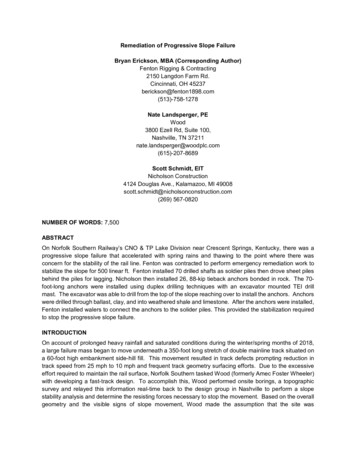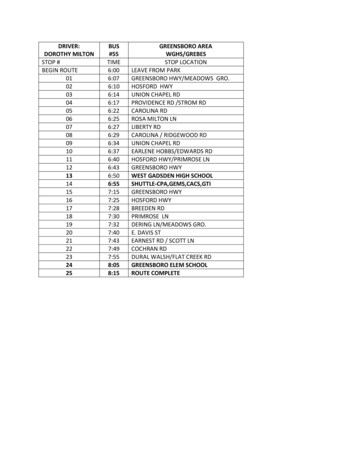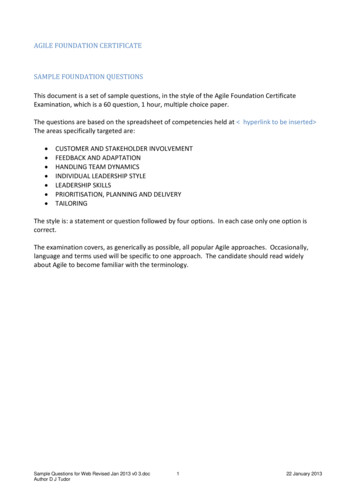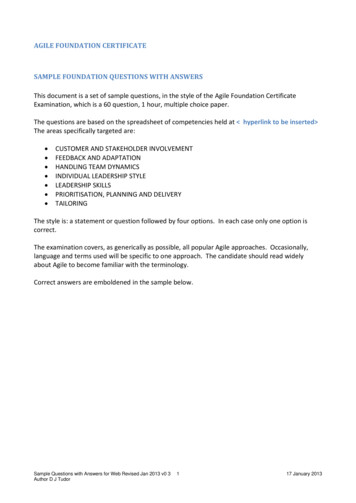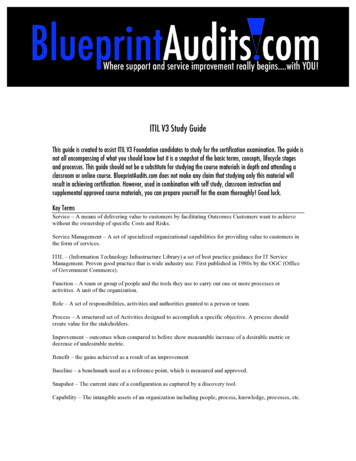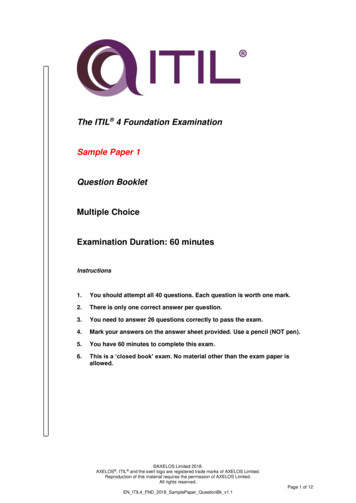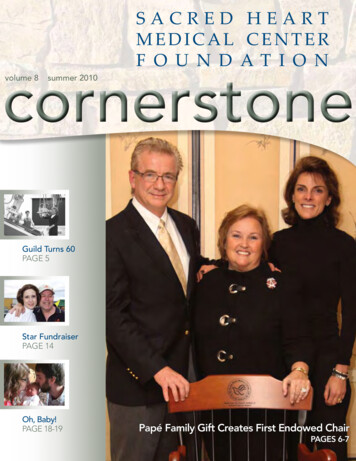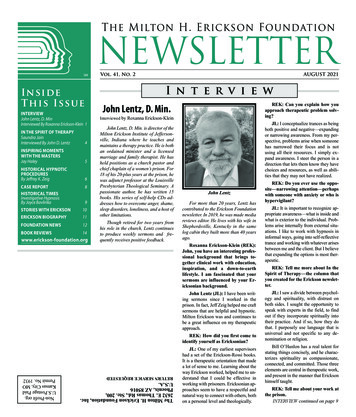
Transcription
The Milton H. Erickson FoundationSMVol. 41, No. 2AUGUST 2021I n t e r v i e wInsideThis IssueINTERVIEWJohn Lentz, D. MinInterviewed By Roxanna Erickson-Klein 1IN THE SPIRIT OF THERAPYSaundra JainInterviewed By John D. Lentz4INSPIRING MOMENTSWITH THE MASTERSJay Haley5HISTORICAL HYPNOTICPROCEDURESBy Jeffrey K. Zeig6CASE REPORTHISTORICAL TIMESInvestigative HypnosisBy Joyce BavlinkaNEWSLETTER89STORIES WITH ERICKSONERICKSON BIOGRAPHY1011FOUNDATION NEWS12BOOK REVIEWS14www.erickson-foundation.orgREK: Can you explain how youapproach therapeutic problem solving?John Lentz, D. Min.Interviewed by Roxanna Erickson-KleinJohn Lentz, D. Min. is director of theMilton Erickson Institute of Jeffersonville, Indiana where he teaches andmaintains a therapy practice. He is bothan ordained minister and a licensedmarriage and family therapist. He hasheld positions as a church pastor andchief chaplain of a women’s prison. For18 of his 20-plus years at the prison, hewas adjunct professor at the LouisvillePresbyterian Theological Seminary. Apassionate author, he has written 15books. His series of self-help CDs addresses how to overcome anger, shame,sleep disorders, loneliness, and a host ofother limitations.Though retired for two years fromhis role in the church, Lentz continuesto produce weekly sermons and frequently receives positive feedback.JL: I conceptualize trances as beingboth positive and negative—expandingor narrowing awareness. From my perspective, problems arise when someonehas narrowed their focus and is notusing all their resources. I simply expand awareness. I steer the person in adirection that lets them know they havechoices and resources, as well as abilities that they may not have realized.John LentzFor more than 20 years, Lentz hascontributed to the Erickson Foundationnewsletter. In 2019, he was made mediareviews editor. He lives with his wife inShepherdsville, Kentucky in the samelog cabin they built more than 40 yearsago.Roxanna Erickson-Klein (REK):John, you have an interesting professional background that brings together clinical work with education,inspiration, and a down-to-earthlifestyle. I am fascinated that yoursermons are influenced by your Ericksonian background.REK: Do you ever use the opposite—narrowing attention—perhapswith someone with anxiety or who ishypervigilant?JL: It is important to recognize appropriate awareness—what is inside andwhat is exterior to the individual. Problems arise internally from external situations. I like to work with hypnosis ininformal ways, going into self-reflectivetrance and working with whatever arisesbetween me and the client. But I believethat expanding the options is most therapeutic.REK: Tell me more about In theSpirit of Therapy—the column thatyou created for the Erickson newsletter.REK: How did you first come toidentify yourself as Ericksonian?JL: I saw a divide between psychology and spirituality, with distrust onboth sides. I sought the opportunity tospeak with experts in the field, to findout if they incorporate spiritually intotheir practice. And if so, how they dothat. I purposely use language that isuniversal and not specific to any denomination or religion.JL: One of my earliest supervisorshad a set of the Erickson-Rossi books.It is a therapeutic orientation that madea lot of sense to me. Learning about theway Erickson worked, helped me to understand that I could be effective inworking with prisoners. Ericksonian approaches seem to have a respectful andnatural way to connect with others, bothon a personal level and theologically.REK: Tell me about your work atthe prison.INTERVIEW continued on page 9John Lentz (JL): I have been writing sermons since I worked in theprison. In fact, Jeff Zeig helped me craftsermons that are helpful and hypnotic.Milton Erickson was and continues tobe a great influence on my therapeuticapproach.Bill O’Hanlon has a real talent forstating things concisely, and he characterizes spirituality as compassionate,connected, and committed. Those threeelements are central in therapeutic work,and present in the manner that Ericksonhimself taught.RETURN SERVICE REQUESTEDThe Milton H. Erickson Foundation, Inc.2632 E. Thomas Rd., Ste. 200,Phoenix, AZ 85016U.S.A.Non-Profit org.U.S.Postage PaidKansas City, MOPermit No. 1932
2VOL. 41, NO. 2The Milton H. Erickson Foundation NewsletterEditor ’s CommentsMuch of what is considered psychotherapy today started out asphilosophy. Philosophers ask the hard questions for which thereare no easy answers, e. g., “What is the nature of ” “What doesit mean to be human?” “What is change?”In many therapies, specifically evidence-based therapies, thesetypes of questions have evolved to produce measurable answers.And as the questions become more testable, the science becomescleaner. Ironically, in the practice of modern psychotherapy, thisis an intermediary stage.But even though psychotherapy now relies more on scienceand results, it is still an art, and one that is relational and spiritual.Metaphorically, therapy has become a dancefloor upon which thetherapist and client dance an I-Thou waltz.I recently finished rewatching the 2020 Evolution presentations. Since I was born before dirt was invented, I have been ableto follow many of the presenters through their evolution from philosophers to scientists and ultimately to humanistic-artists-with-scientific-scaffolding. Watchingthe demonstrations, it is often difficult to tell who is leading and who is following.In preparation for the 2021 Evolution Conference in Anaheim, California inDecember, this issue is dedicated to elements that are an impetus for that evolution.We begin with our featured interview of John Lentz, an ordained minister,MFT, and our media reviews editor. For more than 30 years, Lentz has been developing Ericksonian principles using his spiritual wisdom. He is a remarkableperson and friend.For In the Spirit of Therapy, Lentz interviews Saundra Jain, a popular presenter at Evolution 2020. Her professional focus is influenced by an expanded version of the medical model where she honors an individual’s definition ofspirituality.In Case Reports, Rubin Battino and Michael Hoyt present “On the Therapeutic Importance of (Sometimes) Being Shocking,” where they share their version ofErickson’s “shock therapy” to facilitate creative moments. It reminds us to knowour audience.In Hypnosis: Historical Reflections, Jeff Zeig writes about Robert Linder, whowas instrumental in bridging psychoanalysis and hypnotherapy.Continuing with historical reflections, Foundation staff member, JoyceBavlinka writes her first article for this newsletter: “Investigative Hypnosis: TheBeginnings of Police Psychology at The Los Angeles Police Department.” It’s afascinating look at how Martin Reiser, author of The Handbook of InvestigativeHypnosis, developed hypnosis and psychology in law enforcement. Please see“Devoted Ericksonian Joins Foundation—Again” to read about how Joyce is affiliated with the Foundation.In this issue, we are treated to several examples of Erickson’s humor. The firstis from the Erickson biography, An Epic Life: Professional Contributions, in whichErickson uses a creative intervention with David Calof. The second is in “Eric theBadger—Alive and Well in the 21st Century.” For several years, Erickson contributed to H.C. L. Jackson’s popular column in the Detroit News, under the pseudonym, Eric the Badger.Also in this issue, Jeff Zeig introduces us to his Emotional Impact Project,which focuses on helping people move beyond knowing something intellectually,to realizing it evocatively. I learned long ago that giving people information rarelyhas impact. Zeig drives this point home and talks about how our modeling artistscan help us become better communicators.Our book reviews for this this issue stay true to the evolution theme. John Lentzselected four to review.We start with his review of Betty Freedson’s Other Realms, Other Ways: AClinician’s Guide to the Magick of Intuition. Bridging the world of psychics andpsychologists, Freedson reminds us that using more intuition, especially in therapy,can be effective.In his review of Changing Minds with Clinical Hypnosis: Narratives and Discourse for a New Health Care Paradigm by Laurence Irwin Sugarman, Julie Hope Linden, and Lee WarnerBrooks, Lentz writes, “After reading this book, you may neverthink of Erickson’s work in quite the same way.” I would have toagree.For his review of Happy Is the New Healthy by Joan Neehall,Lentz includes a quote by Neehall:“I believe that happiness issomething that should not be hunted down; rather it should be astate of being, and something we come by naturally, just likebreathing.” Neehall explains how we how we often get in our ownway of eliciting that natural state within.In his review of Understanding Ericksonian Hypnotherapy:Selected Writings of Sidney Rosen edited by Victor Kiarsis, Lentzwrites, “By selecting and editing the papers of Sidney Rosen, Victor Kiarsis offers a loving gift to therapists and the field of psychotherapy. This book is wonderful not only because offers a unique perspectiveof Erickson, but it also delves into how to use the techniques and tools for whichhe was well known.”Given my interest in treating trauma, I am especially appreciative of Kate Hubert Bilotta’s review of Rethinking Trauma Treatment: Attachment, Memory Reconsolidation, and Resilience by Courtney Armstrong. Bilotta points out thatArmstrong summarizes some of the best insights from effective methodologiesand how multiple perspectives can result in a unique multidimensional perspective.Finally, we have a special review by Roxanna Erickson-Klein of MichaelEDITOR’S COMMENTS continued on page 8The Milton H. Erickson FoundationNEWSLETTERExecutive Editor: Richard Landis, Ph.D.Associate Editor: Marnie McGannMedia Reviews Editor: John Lentz, D.Min.Institutes Editor: Marilia Baker, M.S.W.Power of Two Editor: Roxanna Erickson-Klein, R.N., Ph.D.In the Spirit of Therapy Editor: John Lentz, D.Min.Case Reports Editor: Eric Greenleaf, Ph.D.Guest Reviewers: Kate E. Hubert Bilotta, LCSW;Joseph Carlton, LMFT; Roxanna Erickson-Klein, Ph.D.Production Manager: Karen HavileyAd rates: www.erickson-foundation.org–Board of Directors–Jeffrey K. Zeig, Ph.D.Helen Erickson, Ph.D., MSN, BSNRoxanna Erickson Klein, R.N., Ph.D.J. Charles Theisen, M.A., M.B.A., J.D.Camillo Loriedo, M.D.Bernhard Trenkle, Dipl.Psych.The Milton H. Erickson Foundation, Inc.2632 E. Thomas Rd., Ste. 200,Phoenix, AZ 85016U.S.A.Telephone: (602) 956-6196FAX: (602) 956-0519www.erickson-foundation.org
The Milton H. Erickson Foundation NewsletterVOL. 41, NO. 23EVOLUTIONIS BACKIN TOWN!Live in Anaheim, CADECEMBER 1–5, 2021L I M I T E D S E AT I N G M AY A P P LY.SAV E YO U R S E AT TO DAY AT A N U N B E ATA B L E P R I C E !evolutionofpsychotherapy.comPAID ADVERTISEMENT
4VOL. 41, NO. 2The Milton H. Erickson Foundation NewsletterIn T h e Sp i ri t Of T h era p yInterview with Saundra Jainnot a religious scholar by any means, but I believe that when we create this typeof psychotherapeutic environment, we allow our patients to find their true path.By John D. Lentz, D.Min.JL: You emphasize a wellness approach/program that includes five wellness-enhancing practices and a positive psychology exercise. How do youmanage to elicit the patients’ strengths across many domains, includingmindfulness?Saudra Jain, MA, PsyD, LPC, is an adjunct clinical affiliate with School ofNursing at The University of Texas at Austin. Her interest is the impact of positive psychology on client outcomes. She explores the connection between wellness and its anti-inflammatory effects, as well as improvement in disease andwellness markers. She is also researching the intersection between psychedelicsand wellness. In 1992, she launched a private therapy practice and currentlyprovides services for a wide range of mental health issues.Dr. Jain is a co-creator of the WILD 5 Wellness Program, which combinesfive elements of wellness—exercise, mindfulness, sleep, social connectedness,and nutrition—with positive psychology practices. In doing so, she offers a simple, prescriptive, wellness program.SJ: I believe that wellness is a state of being that evolves from a way of living. Our program is based on five wellness-enhancing practices, including exercise, mindfulness, sleep, social connectedness, and nutrition. In addition, wehave included daily positive psychology exercises about happiness, enthusiasm,resilience, and optimism (HERO exercises), and we include gratitude exercises.We encourage patients/research participants to avoid aiming for perfection, bytelling them that perfection is not the goal of the program. We encourage selfcompassion throughout the program.Jain is coauthor of two well-received workbooks:KickStart30: A Proven 30-Day Mental Wellness Program, and LiveWell90: A Proven 90-Day Mental Wellness Program; and coauthor of The Science andPractice of Wellness: Interventions for Happiness, Enthusiasm, Resilience, and Optimism (HERO), publishedby Norton in 2020.I spoke earlier about the mindfulness practice, whichfor many is a bit of challenge, as it is often a new and unfamiliar practice. We encourage openness and a willingness to try all of the practices for 30 days, and thenevaluate their results. At that point, they can make an informed decision about how they want to incorporatethese practices into their daily lives.John Lentz: Saundra, you and your husband arethe epitome of the medical model. Yet, in addition,you research and present wellness-based programsthat enhance a person’s life rather than just treat disease. You deserve credit and are still pushing the envelope. It seems that you have managed to integratespirituality into your practice. Can you tell us moreabout the evolution of your work?JL: One definition of wellness that I came acrossin your materials seemed wonderful because it is sobroad and influenced by positive psychology. Youtalk about it being more than individual behaviors.You say it is a mindset. Can you speak about this?SJ: I love the World Health Organization’s definition of wellness given in 1948: “ a state of completephysical, mental and social well-being and not merelythe absence of disease or infirmity.” This really says itall. It is a holistic approach to wellness—the whole person—and not just a disorder or a clustering of symptoms. I’m not saying those things aren’t important interms of treatment, but it doesn’t seem like a completetreatment plan without the inclusion of wellness. As clinicians, I believe that in taking care of patients, we mustincorporate wellness into our thinking and our treatmentSaundra Jain: Thank you for the kind words, John.During my academic training in the early ‘80s, wellnesswas not part of the curriculum. What a missed opportunity! In clinical practice, it became clear that many patients improved symptomatically and functionally. I ambig believer in measurement-based care, and a wellnessSaundra Jainscreener revealed that even in these patients, wellnessscores were quite low. This realization opened up theplans.world of wellness for me, and led to developing an evidenced-based wellnessJL: Do you advocate spirituality to your students to use in their work?program called WILD 5 Wellness—a 30-day prescriptive and trackable proIf so, how?gram.One of the wellness-enhancing practices of the program is mindfulness. Inthis 30-day program, we recommend 10 minutes of daily mindfulness meditation and I’m happy to report we’ve found positive results based on pre-postmeasurements of mindfulness. If we go with Dr. Jon Kabat Zinn’s definition ofmindfulness—paying attention in a particular way, on purpose, in the presentmoment, and without judgement—I believe that this taps into a spiritual spacefor many. Being fully present and filled with connection and compassion is bothmindful and spiritual.JL: Because of your respect for your patients’ relationship with God orlack of one, you have managed to encourage spirituality without advocating any particular religion. Could you speak to how you understandthis?SJ: Let me share a quote from Michael Singer, an acclaimed author and spiritual teacher, as he answers this question quite nicely: “The highest spiritual pathis life itself.” Psychotherapists, or anyone in a helping profession, has a responsibility to hold space for patients. It would be inappropriate for us to project our beliefs and opinions—whether religious or political—onto those in ourcare. I do my best to remain aware of my own biases and continually create aspace of safety and curiosity, in hopes of better understanding my patients. I’mSJ: Let me answer your question this way. In all my interactions with others, I stress the importance of wellness, good self-care, self-compassion, curiosity, and openness. I believe this approach opens the door for our patients, aswell as our students, friends, family, neighbors, and colleagues, to find their truepath, whatever that may be.JL: You have wonderful stories of mindfulness, wellness, and spirituality. Would you be willing to share one?SJ: I would love to. There are so many that come to mind. I’m reminded ofa participant from one of our WILD 5 Wellness studies. She has rheumatoidarthritis and was referred to the study by her rheumatologist. She was in a lot ofpain and had to retire early due to disease-related disability. Before beginning thewellness program, she told her rheumatologist that she was “sick and tired ofbeing sick and tired.” She said, “Nothing I have done up to this point seems tobe getting me over the hump both mentally and physically.” After completing thestudy, here is what she shared: “Being on the program has made me mindful,present, and has increased my gratitude, my awareness, and my listening skills.It has decreased my pain, my anxiety and depression, and has even regulated myhigh blood pressure.”SPIRIT OF THERAPY continued on page 6
The Milton H. Erickson Foundation NewsletterVOL. 41, NO. 25In spiring Moments With The M astersAfter reading Uncommon Therapy, JayJay Haley:Haley—one of Erickson’s most accomplishedstudents—became one of my idols in the field.Perspectives on the MastersIn early 1980, I finally met him, and, followingBy Jeffrey K. ZeigOut of all the psychotherapy teachers I have learned from in the last 50 years, JayHaley stands as one of the most important. Haley was neither my undergrad teacher norwas he my graduate teacher. I first learned from Haley by reading his books. He editeda compendium of Erickson’s papers that is no longer in print. That work introduced meto Milton Erickson. It also sent me on search to learn more by reading Haley’s writings.After I earned my professional degree, I began attending his workshops and lectures.Haley was one of the founding fathers of brief and family therapy. He was the architect of the strategic model of psychotherapy. He did not have an explicit theory ofhuman behavior. Rather he had methods of intervention whereby the therapist took responsibility for promoting change.As member of the Bateson Project in the 1950s, Haley was one of the authors ofthe project’s seminal paper on the double bind theory. He eventually left Californiaand moved to Philadelphia to work with Salvador Minuchin at Philadelphia ChildGuidance. From there he moved to Washington D.C. where he collaborated with hiswife, Cloé Madanes, to advance strategic therapy.I attended as many workshops as I could. Haley and Madanes were bellwethers inpsychotherapy training. We were all were eager to learn from them. Their workshopswere in high demand and the venue was always packed with students.In December 1973, as I traveled to meet Milton Erickson for the first time, I had acopy of Haley’s newly published book, Uncommon Therapy. That book not only putErickson on the map as one of the leading proponents of a strategic approach to psychotherapy, but it also prepared me for my first encounter with him. At that time, Erickson’s position was starkly different from two widely accepted approaches: thehumanistic approach and psychodynamic method.SPIRIT OF THERAPY continued on page 6Erickson’s wishes, I invited him to keynote thefirst International Congress on Ericksonian Approaches to Hypnosis and Psychotherapy. Whenhe arrived for the event, I greeted him at theHyatt Hotel in Phoenix. We walked across thestreet to Symphony Hall at the Phoenix Convention Center where he would be speaking tomore than 2,000 professionals. As we made ourway down the aisle toward the stage, I timidlyasked him if he ever got nervous speaking inJay Haleyfront of large groups. He quipped, “largegroups?” meaning that any size group made himnervous. For a moment, I was awash in relief that he had vulnerabilities that I experienced.Haley’s keynote address at the Erickson congress was stellar. With wit, wisdom,and heartfelt emotion, he spoke about the recent passing of Milton Erickson and howmuch Erickson had impacted him and the field of psychotherapy. It was a poignanttribute. Here is a link to the text of that speech: torytelling-jay-haley/Over the years, I had several opportunities to share the podium with Haley. Attimes, I was tentative. I remember being on a panel in Germany with him, SalvadorMinuchin, and Gianfranco Checchin. All three men were incisive geniuses with imposing styles. To use a hand-to-hand combat analogy: Haley wielded a rapier and Minuchin a hefty club, while Cecchin employed judo. I was young and intimidated, but Iknew enough to bob, weave, and duck.In 1985, I organized the Evolution of Psychotherapy Conference, and, of course,INSPIRING MOMENTS continued on page 7
6VOL. 41, NO. 2The Milton H. Erickson Foundation NewsletterHistor ical Hypnotic Procedurestivants as the unresolved OedipusRobert M. Lindnersituation or castration anxiety.”By Jeffrey K. ZeigIn this column, Jeffrey Zeig reviews historical books to shed light onthe evolution of hypnotherapy.Psychiatrist, Robert M. Lindner (1914 -1956), M.D., was instrumental inbridging psychoanalysis and hypnotherapy.In the first half of the 20th century, psychoanalysis was the predominantform of mental health therapy. The roots of psychoanalysis, of course, dateback to the 19th century when Sigmund Freud believe that analyzing one’spast was imperative for the patient to move forward into the future. Freud believed that hypnosis disrupted transference, which is predominant in psychoanalysis, and he did not champion the use of hypnosis.Hypnosis lay in dormancy until after WWII, and the ground was fertilefor the development of hypnoanalysis. Lindner, a colleague and collaboratorof Milton Erickson, was key in that development. Although little is known ofLindner and Erickson’s collaborations, there is a silent film of them workingtogether on an experiment concerning the hypnotic induction of a subject withcolorblindness.Analyzed by Theodore Reik, Lindner wrote several books, including TheFifty-Minute Hour (1955), a collection of psychiatric tales, and his mostknown published work, Rebel Without a Cause: The Hypnoanalysis of a Criminal Psychopath (1944), the annotated transcript of 46 sessions of hypnoanalysis with a single patient.(Of Note: In 1955, James Dean starred in a movie about an emotionallyconfused middle-class youth, the title of which was derived from Lindner’sbook.)In the preface to Rebel Without a Cause, Lindner expresses his gratitudeto Milton Erickson who at the time of the book’s publication was 42 yearsold. Lindner writes that Erickson is “a source of inspiration and encouragement.”Lindner describes hypnoanalysis as “a compound of psychoanalysis andhypnosis.” He says that “using the interpretive core of psychoanalysis,” hypnosis validates the data of analysis and provides “a fixative means for thetherapy without which analysis is no more than an exercise in diagnosis.” (pp.15)In subsequent chapters in the book, Lindner discusses the psychogenesisof the criminal psychopathic state, and its “dynamic centralism of such mo-SPIRIT OF THERAPYLindner’s view of hypnosiswas common to psychoanalysts.He maintained that hypnosis and“suggestive therapy” could beseen as limited to symptom amelioration. “In the enthusiasm for‘cure,’ the obligation to discoverand deal with causes has beenstudiously and conveniently ignored by all except such flinty pioneers as Janet and the Frenchschool, and in this country, Erickson and Kubie, as well as various assorted daring souls.”(pp.16)Robert LindnerLindner notes that hypnosis is often criticized for offering only a temporary cure. He writes: “Anna Freud stated that in hypnosis, the ego could takeno part in the therapeutic procedure, implying that the patient was robbed ofthe cathartic working-through of the precipitating events.” (pp.17) Hypnoanalysis, therefore, was the proper method.According to Lindner, psychoanalysis has a “ritualistic character, its insistence upon punctilious cant, and unrelaxed ceremony.” (pp. 16) In comparison to time-consuming psychoanalysis, hypnoanalysis is oftenaccomplished in three or four months.The first few weeks of a patient’s hypnoanalysis with Lindner, were typically dedicated to trance training and deepening, using post-hypnotic suggestion, which then led to the hypnotic revivification of memory. In the nextphase, he used hypnotic recall to facilitate free association.As to the memories called forth by hypnoanalysis, Erickson described twoforms: regressive and revivified. Regressive memories are the patient’s memories of the past. With a revivified memory, the patient revives a buried orsuppressed memory, and often relives the experience.Robert Lindner was the right man at the right time, holding analysis inone hand and hypnosis in the other. Erickson, of course, carried forth the torchof hypnosis while psychoanalysts continued to focus on causative factors.continued from page 4It is not possible for me to share in this short interview the importance andprofound impact of wellness. Granted, not every patient will have the degree ofpositive impact that this woman had, but her story deserves our attention.JL: You know quite a bit about hypnosis, and understand how to utilizeit in indirect ways. Do you teach those approaches to your students directly,or only through modeling?SJ: I value hypnosis a great deal both personally and professionally. I see itas an effective modality that is under-utilized. I benefitted greatly from hypnotherapy in my early 30s in dealing with the fear of public speaking. I’m grateful to the practitioner for allowing me via a trance-state to release andreformulate my fears. From that point forward, I have referred my patients toclinical hypnotherapists for specific work that has proven beneficial from thismodality. In teaching about mindfulness, I almost always include some sort ofexperiential practice, but I’ve not done that with hypnosis. Thanks for plantingthat idea, John.JL: It was a joy talking with you.(pp. 285). By the end of the book,Lindner’s patient displays signsof better adaptation in society.Join our mailing list aterickson-foundation.orgfor advance notice ofstreaming videos of MiltonErickson at his teachingseminars.
The Milton H. Erickson Foundation NewsletterVOL. 41, NO. 27Virtual Couples Conference Mini ReviewBy Jeffrey Zeigvice to non-binary and LGBTQIA people.The Couples Conference 2021 was virtually held in early June. Attendees wereuniformly appreciative of the diversity of topics in the speeches and panels.Bill Doherty discussed polarization in intimate and civic life. He includedmethods of working with couples of differing political orientation.Conference organizer, Ellyn Bader, opened the program with an engaging andinformative multimedia presentation on the therapy of couples who work together.She discussed the need for relational structure and defining roles. She also presented six skills that these couples need to employ to be more effective as partners,including commitment and negotiation. She stressed that interdependence worksbest when all issues are openly addressed.In his keynote, Stan Takin covered the explicit principles that guide relationships to grow, including shared mythologies, devotion to safety and security, andcommon purpose.One highly rated panel featured Martha Kauppi, Shawn Giammattei, and StanTatkin. They discussed working with sexuality in an online world and offered ad-INSPIRING MOMENTSOther distinguished faculty, including Terry Real, Harville Hendricks, HelenLaKelly Hunt, Joseph Winn, and Carolyn Welch, discussed topics such as highlyreactive couples, gender affirmative relationships, desire, working with men, andmindfulness.To stream the content, see couplesconference.com.continued from page 5invited Haley and Madanes. A bit naive, I scheduled Haley as the discussant for theMasterson’s paper on the object relations approach to therapy. In other words, I mixedoil and water, or rather flint and steel. Fortunately, my friendship with both men wasnot affected. (A side note: I also scheduled Masterson as the discussant for MurrayBowen. Live and learn!)Of Masterson’s paper, Haley said that psychoanalysis had died in the middle of the1950s. He rebuked the diagnosis of “borderline,” calling it basically irrelevant. He criticized inpatient treatment of adolescents and favored family therapy. He wondered outloud how renowned experts could have such polar positions. (Those interested, canfind the dialogue between the men in The Evolution of Psychotherapy; Zeig, J.K., Ed.,Routledge, 1987.)In 1986, I organized an Erickson congress as a tribute to Jay Haley and his work,honoring him as a giant in the field. The proceedings from that conference were pub-lished in Changing Directives: The Strategic Therapy of Jay Haley (Zeig, J. K., Ed.,2001).I continue to be mesmerized by Jay Haley’s work. He offers remarkably astuteanalyses in an admirable writing style. And he continues to impress me because hiscontributions have proved tim
Investigative Hypnosis By Joyce Bavlinka 9 STORIES WITH ERICKSON 10 ERICKSON BIOGRAPHY 11 FOUNDATION NEWS 12 BOOK REVIEWS 14 Interview John Lentz, D. Min. Interviewed by Roxanna Erickson-Klein John Lentz, D. Min. is director of the Milton Erickson I

